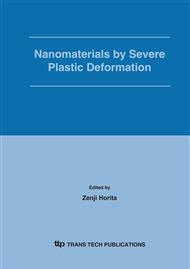p.133
p.141
p.149
p.155
p.161
p.169
p.175
p.179
p.185
Enhancement of Ductility and Strength through Microstructural Refinement by FSP of Nickel Aluminum Bronze
Abstract:
Friction stir processing (FSP) is a severe plastic deformation (SPD) method that has been applied to as-cast NiAl bronze (NAB) materials, which are widely used for marine components. The thermomechanical cycle of FSP results in homogenization and refinement, and the selective conversion of microstructures from a cast to a wrought condition. The physical metallurgy of NAB is complex and interpretation of the effects of FSP on microstructure has required detailed analysis by optical and electron microscopy methods. Annealing and isothermal hot rolling have been employed to confirm microstructure-based estimates of stir-zone peak temperatures. The variation of mechanical properties was assessed by use of miniature tensile samples and correlated with microstructure for samples from stir zones of single and multi-pass FSP. Exceptional improvement in strength – ductility combinations may be achieved by FSP of NAB materials.
Info:
Periodical:
Pages:
161-168
Citation:
Online since:
January 2006
Price:
Сopyright:
© 2006 Trans Tech Publications Ltd. All Rights Reserved
Share:
Citation:


